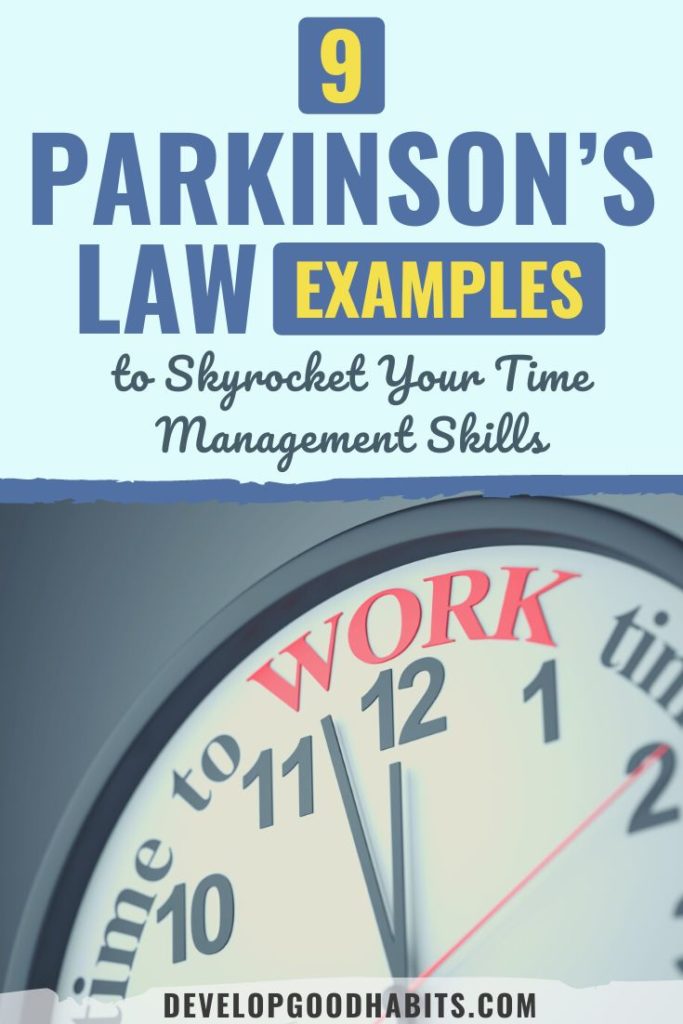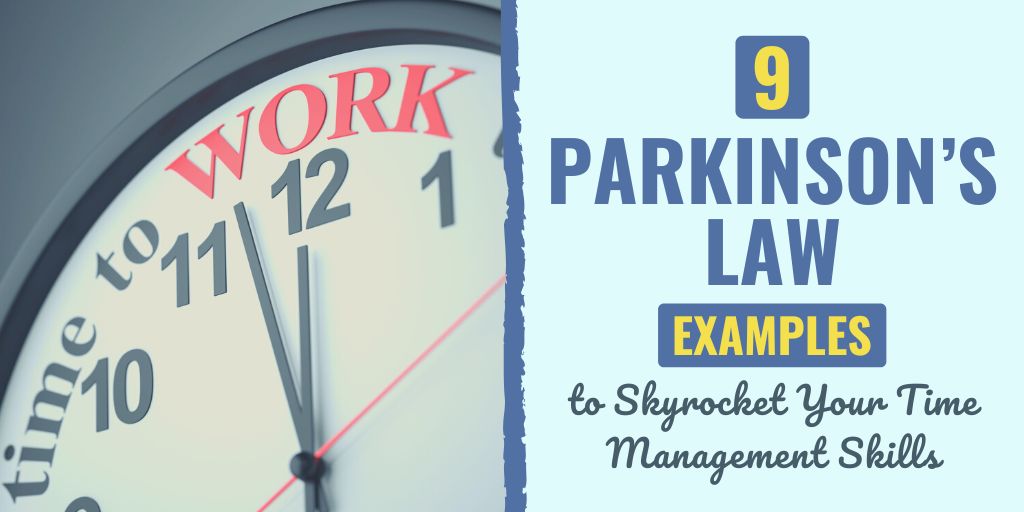There might be affiliate links on this page, which means we get a small commission of anything you buy. As an Amazon Associate we earn from qualifying purchases. Please do your own research before making any online purchase.
Do you find yourself completing projects at the last minute?
Do you ever wish that you got more accomplished, considering the amount of time you spent on a task?
Or do you simply want to get better results from the work you do in life?
I would assume most people fit into at least one of the three categories mentioned. Some people are procrastinators, and some just give themselves too much time to worry about projects that aren't that big of a deal.
To help you become more productive, it is important to learn and apply a simple rule called “Parkinson's Law.”
In this article, I’ll define Parkinson’s Law, tell you why it’s a powerful concept, and then provide actionable strategies to help you apply this rule to your life.
Let’s start with a simple definition.
What is Parkinson's Law?
Coined by British historian, theorist, and author Cyril Northcote Parkinson, Parkinson’s Law is the idea that the amount of required work to accomplish a task will increase depending on its deadline for completion. This causes a person to perceive that there is more work than there is.
For example, if you give yourself a week to do a task that will take three hours to complete, then (psychologically) the task’s complexity will expand. Dread over this perceived difficulty sets in, eating at you the whole week. The result is, of course, lost productivity on your part.
While it might not fill the entire time with more work, your stress and tension about finishing the task increase over the entire week. You end up spending more time worrying than it would to fulfill the obligation.
This may explain why students choose to cram before exams, or why people complete projects at the very last minute. But if you assign the right amount of time to each of your tasks, you can gain back time, and the tasks will not seem so complex.
In Tim Ferriss' book, The 4-Hour Workweek, Ferris discusses the mental strain deadlines have on people.
If you are given just one day to complete a project, you will be forced by the time pressure to focus on finishing it and on completing the bare essentials. After all, remember that 80% of your success comes from just 20% of your efforts.
But when you are given a week to do the same project, likely the first six days will be spent overthinking it. Odds are that both end products would be of similar quality, too. How much work you can squeeze into a small time frame is surprising.
With this framework, Ferriss poses two questions. Should people prioritize what tasks to work on resulting in a decrease in time spent on work? Or should work deadlines be shortened so people can concentrate on the most necessary tasks instead?
He argues that it is best to do both. Pick out only your most critical tasks, and then give yourself short and clear deadlines.
Parkinson’s Law in Time Management and Productivity
As you can see, the more time you allow yourself to complete a task, the longer you'll put it off. In order to manage your time in the most effective way, you have to shorten the amount of time you are willing to allow yourself to finish something.
If you need to accomplish something in a year, it will take you a year to do it. If you have to do something in a month, then it will get done in a month.
One might argue that if Parkinson's Law were an accurate observation, you could assign a task a time limit of two minutes, and the task would become easy enough to do within that time limit.
But Parkinson’s Law is an observation, not a form of magic. It has been observed because people tend to allow themselves to have more time than they actually need to get something accomplished.
This is often because they want a buffer, but also because people have an inflated idea of how long it should take to finish a task. People don’t realize how fast some tasks can be finished until they test this observation.
When you are assessing your own capabilities, or the capabilities of the person you are assigning a task to, you have to be objective and stick to the facts. Where do your strengths and weaknesses lie, and how much of this project is likely to trip you up?
This will help you determine the right amount of time needed to complete a task or finish a project.
You also want to aim to under-promise and over-deliver. People make and fulfill their promises because it builds the foundation that is needed for maintaining relationships. Large promises mean large obligations and big expectations. If the expectations are not met, people get upset and feel let down.
Promises help signal to others how trustworthy you are. The human brain expects consistency, so when someone makes a promise, your brain finds comfort in believing whatever was promised will happen.

But when the promise does not get fulfilled, the consistency your brain expected goes away. This leads to disappointment and alters how people perceive you.
In order to under-promise and over-deliver, give yourself artificial limitations to your work. When you are working on a project, make yourself a personal deadline, and then announce a later deadline to those who are counting on you. This way, you will have the work done before they expect it.
Josh Kaufman has created a business from his ability to refine the core principles of business and teach them quickly and concisely to anyone in the working world.
In his book, The Personal MBA, Kaufman recommends using Parkinson’s Law as a counterfactual simulation question (also known as a “What if” question), asking what would it look like to complete a task in a very short amount of time.
If you can visualize yourself doing this and the steps you would need to take to get there, you will be able to do it. Mentally cut out any extra steps that are not necessary.
Now, let’s get to the nine Parkinson’s Law examples you can use to improve your time management and productivity efforts:
1. Use the Pomodoro Technique.
The idea behind the Pomodoro technique is to break up each of your tasks into 25-minute time blocks. Every 25 minutes, take a five-minute break. After finishing four 25-minute sessions, take a 15- to 30-minute break.

This strategy is effective because you fully concentrate on one task for the 25 minutes without changing your focus or multitasking.
During those 25 minutes, you ignore incoming emails, text messages, or other distracting activities such as social media. You are just completely focused.
If you want to get started on using the Pomodoro technique, read our review of the best Pomodor apps to help you improve your productivity.
Or you can also check out this video that explores how the Pomodoro technique can help you become hyper-focused on important tasks.
2. Track how you spend your time.
To be more productive, you have to know exactly how you are spending each hour and minute of your day.
You may think that you need to get more accomplished or there’s never enough time to do everything, but try tracking how you spend your time. Likely, you will realize how much time is spent on unnecessary tasks, which you can then eliminate.
Maybe you’re experiencing resistance towards the idea of logging this. Author, speaker, and time management expert Laura Vanderkam writes in an article about time tracking that this could be caused by guilt.
By ignoring the areas that are neglected due to lack of management, we are not confronting how our time is spent. However, tracking our time absolves us of this guilt.
Trackers help us recognize when it’s best to focus on work or leisure. They create a visual image of where we’re expending our precious hours on unnecessary tasks so we can reclaim them for our own needs.
3. Take frequent breaks.
You will likely be surprised by how often and how long you should take breaks in order to increase your productivity.
In fact, the top 10% of the most highly productive people take a break for 17 minutes after every 52 minutes of focused work.
This may seem like a lot of downtime—and if you’re working a 9-5 day, it is. But this time ratio was proven to increase productivity through an experiment using the time-tracking app DeskTime or RescueTime.

4. Get an accountability partner.
Having an accountability partner is an effective way to help you stay on track toward achieving your goals and getting the results you want.
An accountability partner can help you with a lot of things, such as dealing with unexpected challenges and setbacks, creating positive and lasting change, carrying out action plans, and improving your personal effectiveness.
Sold yet? If so, this article provides a five-step plan to find the perfect accountability partner for yourself.
Let’s break them down first:
Step 1: Find the right person for yourself.
Step 2: Consider someone different from you.
Step 3: Propose your idea to them.
Step 4: Schedule a meeting.
Step 5: Create weekly accountability statements.
5. Make a time limit rule.
Make a rule for you to get things done before a set time.
For example, say there is one task that you have to do every day, and you can't really be productive until you get it done.
Maybe this is checking your voicemails on your work phone, or reviewing a traffic sheet for your company. Whatever it may be, make a rule for you that this will be done within 30 minutes of arriving at work.
You can also make a rule that you will be done with your work for the day by 5:30 pm. This way, you will have a clear cut-off between when your professional life is over for the day and your personal life begins.

6. Limit certain tasks to 30 minutes a day.
Think about the things in your life that are time suckers. These can include scrolling through social media, checking your emails, and texting as a few examples.
Limiting these activities to 30 minutes each day to give yourself enough time to get the work done that you need to do, and have time left over to spend with your loved ones.
One benefit to limiting the time spent on certain tasks is how it has you evaluate your life’s priorities. One way to delegate this information is by using an Eisenhower Matrix, which enables a person to sort tasks by their importance and urgency.
Using this system to sort your daily tasks and obligations allows you to prioritize what you need to accomplish. This means less procrastination and wasted time, and more productivity on what really matters.
7. Stop working late.
Do not work past your working hours. With Parkinson's Law in mind, create time boundaries and deadlines that prevent you from having the time during the day to sit around and think about doing things.
Creating a specific window for window hours will lessen the stress in your life. Without the two bleeding together, you can compartmentalize your life to focus strictly on what’s at hand. Allow working hours for work only, and leisure hours for leisure.
8. Remove half-work
James Clear, the author of Atomic Habits, defines half-work as “the division of your time and energy” between tasks.
An example of half-work is splitting your attention between a presentation you are creating and your email inbox. Because you’re not fully invested in either task, each takes more time than it actually should.
Herein lies the issue: less engagement on a task means more time spent completing it. You perceive the obligation as requiring more effort than it does in reality, resulting in a cycle of extra work.
Always exert the greatest amount of attention you can on a task. Your future self enjoying their relaxed free time will thank you later.
9. Generate urgency
Remember our earlier advice of creating artificial deadlines to encourage productivity? What if you could create a sense of urgency for all your undertakings?
Urgency can get a bad rep. You may associate it with crunching work down to the wire. It doesn’t, however, need to be either of these things.
Instead of associating urgency with excessive, last-minute stress, think of urgency as what propels a person forward. It is how you can charge forward and launch directly into action.
In contrast to dwelling on how long it will take to accomplish that task on your to-do list, choose to jump straight into it. No thinking, no hesitation. Firm and decisive action is what pushes your job from unfinished to complete.
Final Thoughts on Parkinson’s Law
Using Parkinson's Law will prevent you from wasting time or making tasks more complicated than they have to be.
Trim your responsibilities down to the bare minimum, and do those tasks with the most effort you can give. This will result in high-quality work and more time to take on more projects or personal activities.
Start to create short time constraints on your goals, and see how productive you can be and how much the quality of your work changes.
Beyond time constraints are countless more ways to build productivity and leverage your career to new heights. This is just the first step in transforming your life into the way you desire.


